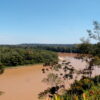Music, dance, art and storytelling have allowed an international team of researchers to reveal aspects of air pollution in Nairobi that would not have been identified otherwise.
Air pollution is a well-documented major human health issue, but despite many air pollution reduction policies designed to improve health, these are frequently ineffective. Often this is because they fail to account for local knowledge, cultural practices and priorities of the intended recipients. Evidence suggests that top-down interventions often fail and therefore people should be put at the center of developing ways around the problem.
Designing meaningful solutions requires in-depth exploration of the relevant issues with stakeholders.
Researchers from the University of Portsmouth, together with researchers and practitioners from the UK, Kenya and Sweden, worked collaboratively with local residents in the informal settlement of Mukuru in Nairobi, Kenya to develop a range of methods including storytelling, music, art and theater to explore understandings of air pollution. Their findings are published in Nature Humanities and Social Sciences Communications this week.
One of the authors of the study, Dr. Cressida Bowyer from the University of Portsmouth, says: “For the first time, a study has placed arts and humanities methods at the center of the exploration of perceptions of air pollution. Our research has pushed the boundaries between disciplines, between research and action, and between experts by education and experts by experience.
“Working with local communities, we were able to uncover contrasting definitions of air pollution, differing perceptions of who was responsible for enacting solutions, and overall a view that air pollution cannot be seen in isolation from the other issues faced by settlement residents.”
The use of these creative methods meant the researchers were able to explore the issue of air pollution with a wide range of stakeholders. The methods enabled local knowledge and experiences to be incorporated into the understanding of the issue, and allowed the voices of those living with the problem to be heard.
Some examples of creative methods include:
Community members made digital stories by taking photographs around Mukuru which, when stitched together and combined with their voiceover, told their story of air pollution.
Trained community researchers facilitated school children to create drawn and/or written stories of their experiences of air pollution.
Theater pieces were presented in key community spaces around Mukuru including at a market, a community center and a football ground. Suggestions were given by the audience about how to resolve the problem and spectators acted out their proposals as part of the theater.
The song ‘Mazingira’ by the Mukuru Kingz, has been played on national radio and television stations with an estimated reach of three million people. The song lyrics explain the problems of air pollution.
Dr. Sarah West, Principal Investigator at the Stockholm Environment Center, says: “From this range of methods we have gained a more complex and nuanced understanding of how air pollution is perceived and understood in Mukuru. The project also created new spaces and forums for dialog and critical reflection on the topic of air pollution in the community.
“We urge other researchers wishing to address multifactorial problems, such as air pollution, to use a mixture of qualitative, participatory and creative methods to engage with a wide range of stakeholders. This can elicit new and unexpected understandings that may not otherwise emerge.”
Researchers concluded that using creative methods and a collaborative, co-created approach, allowed them to reveal aspects of air pollution that they would not otherwise have identified, and led to a more complex, nuanced and holistic understanding.
More information:
Sarah E. West et al, Using a co-created transdisciplinary approach to explore the complexity of air pollution in informal settlements, Humanities and Social Sciences Communications (2021). DOI: 10.1057/s41599-021-00969-6
Provided by
University of Portsmouth
Citation:
How can music, dance and art help improve air pollution? (2021, December 3)



